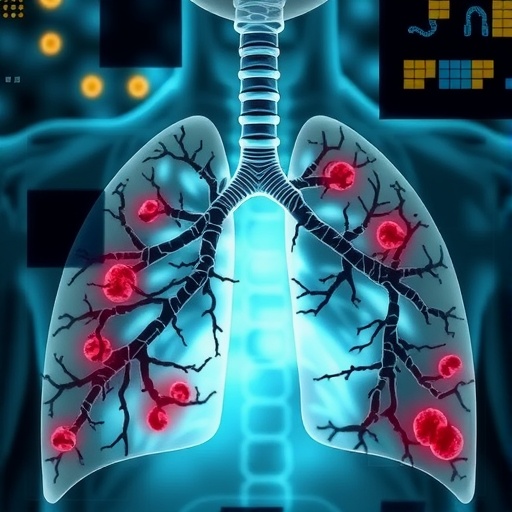In a groundbreaking study published in J Transl Med, researchers led by Huang, C., along with collaborators He, J., and Fu, X., highlight the intricate relationship between multi-site microbial features and the risk of malignancy in pulmonary ground-glass nodules (GGNs). This prospective multicenter cohort study explores how microbial signatures residing in the lungs can serve as potential predictive biomarkers for cancer, particularly highlighting their implications in early diagnosis and intervention strategies. The research is timely, shedding light on the importance of understanding the microbial milieu in the context of pulmonary health and disease.
Ground-glass nodules, often detected incidentally via imaging studies, pose a significant challenge in chest radiology and oncology. While many GGNs are benign, a substantial subset may harbor malignancy potential, necessitating reliable methods for early detection. The study by Huang and colleagues brings an innovative angle to conventional diagnostic frameworks by integrating microbiological insights into the assessment of these nodules. Their findings are poised to change how clinicians approach incidentally found GGNs, potentially leading to more individualized patient care.
The research team conducted a multicenter cohort study involving a diverse population of participants. By analyzing sputum samples and bronchoalveolar lavage (BAL) fluid from patients presenting with GGNs, they characterized the microbial composition across multiple sites in the lung. This thorough analysis not only sought to identify distinct microbial patterns associated with malignancy but also aimed to delve deeper into the biological underpinnings that might link these features with cancer development. Such multifaceted investigations are essential, as they pave the way for a more comprehensive understanding of the tumor microenvironment.
A striking element of the study is the identification of specific microbial signatures that correlate with malignant versus benign nodules. By employing advanced sequencing techniques, the researchers uncovered distinctive bacterial and fungal profiles that varied between patients with different risk levels. These findings are particularly significant as they suggest a possible role of microbial dysbiosis in tumor pathogenesis. The implications of such microbial imbalances could be vast, potentially influencing not only diagnostic criteria but also therapeutic strategies aimed at modifying the lung microbiome to favor health over disease.
In addition to identifying microbial features, the study also focused on their predictive capabilities. The researchers developed a model that utilizes microbial data to assess malignancy risk more accurately, potentially enhancing the prognostic value of imaging findings. This model signifies a shift toward precision medicine, emphasizing the need for tailored approaches that consider not only genetic but also microbial factors in cancer risk assessment. As healthcare becomes increasingly personalized, integrating such microbial information is instrumental in improving patient outcomes.
Moreover, the study places an emphasis on the clinical applications of these findings. The identification of microbial biomarkers opens new avenues for early intervention, possibly leading to the development of non-invasive screening tests that could be employed in routine practice. For instance, a simple analysis of sputum or BAL fluid could provide valuable insights, enabling clinicians to stratify patients based on their malignancy risk more effectively. This not only optimizes resource allocation but also enhances patient safety by minimizing unnecessary invasive procedures.
The researchers are keen to underscore the need for further validation of their findings. While the initial results are promising, additional studies are required to confirm the utility of these microbial signatures in various populations and clinical settings. Replicating these findings in larger cohorts will be crucial for establishing robust, evidence-based guidelines for integrating microbiological analysis into routine clinical assessments of GGNs.
Equally important is the potential for this research to stimulate deeper inquiries into the lung microbiome’s role in overall pulmonary health. While the current focus is on malignancy risk, the implications of microbial features extend beyond cancer. Understanding how these microbial communities interact with host cells could unveil new insights into inflammatory lung diseases, infections, and even the body’s immune response mechanisms. Researchers may find that targeting microbial health could yield benefits across a spectrum of pulmonary conditions.
As this area of study matures, collaboration between microbiologists, oncologists, and pulmonologists will be essential. Interdisciplinary efforts will facilitate the development of comprehensive strategies that address the complex interplay between microbial communities and lung pathology. By combining expertise from various fields, the scientific community can generate a more nuanced understanding of health and disease dynamics in the respiratory system.
In conclusion, the work led by Huang and colleagues marks a significant advancement in our understanding of pulmonary ground-glass nodules and their malignancy risk. By illuminating the connection between microbial features and cancer, this study opens the door to innovative diagnostic tools and therapeutic approaches. As researchers continue to unravel the complexities of the lung microbiome, the promise of more effective, personalized healthcare becomes increasingly tangible. The potential impact on clinical practice could be profound, paving the way for transformative changes in how we approach lung health and disease in the future.
The integration of these microbial considerations signifies a progressive leap in oncology and pulmonology, reinforcing the necessity for ongoing research and collaboration in this exciting frontier of medical science. The findings of this study will likely resonate within the scientific community and beyond, inspiring further studies designed to harness the power of the microbiome in chronic disease management and prevention strategies.
Subject of Research: The relationship between multi-site microbial features and malignancy risk in pulmonary ground-glass nodules.
Article Title: Association of multi-site microbial features with malignancy risk in pulmonary ground-glass nodules and identification of predictive biomarkers: a prospective multicenter cohort study.
Article References:
Huang, C., He, J., Fu, X. et al. Association of multi-site microbial features with malignancy risk in pulmonary ground-glass nodules and identification of predictive biomarkers: a prospective multicenter cohort study. J Transl Med (2025). https://doi.org/10.1186/s12967-025-07483-2
Image Credits: AI Generated
DOI: 10.1186/s12967-025-07483-2
Keywords: pulmonary ground-glass nodules, malignancy risk, microbial features, predictive biomarkers, multicenter cohort study, lung microbiome, cancer detection, precision medicine.




